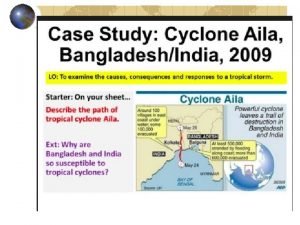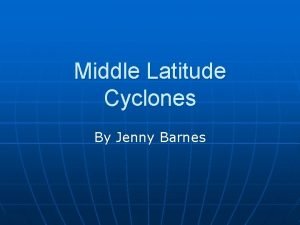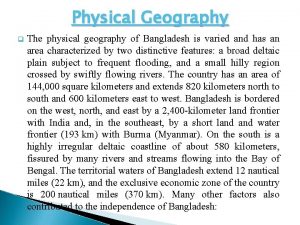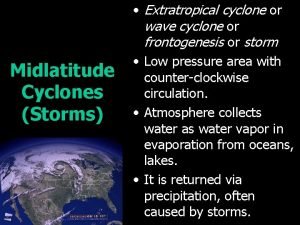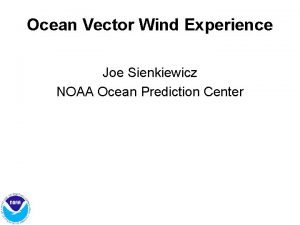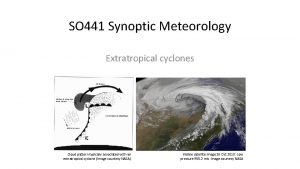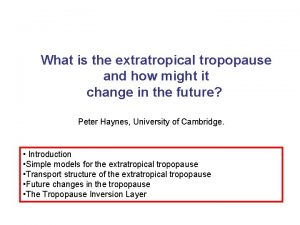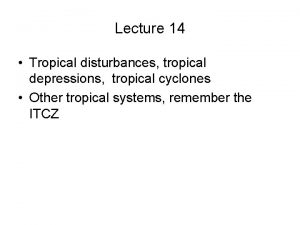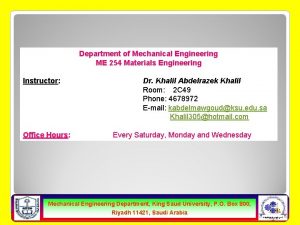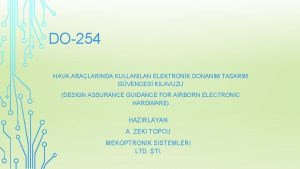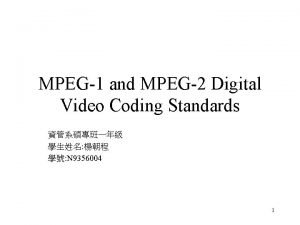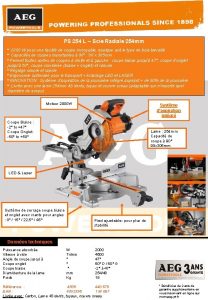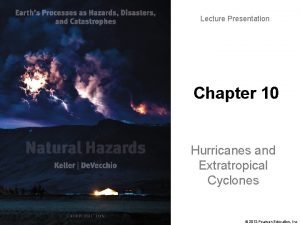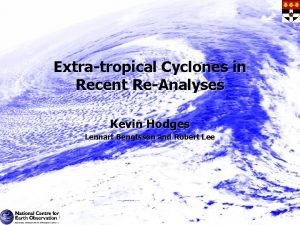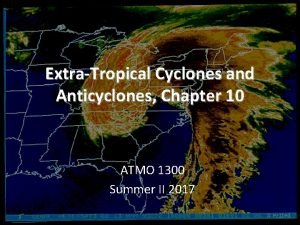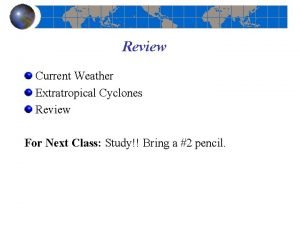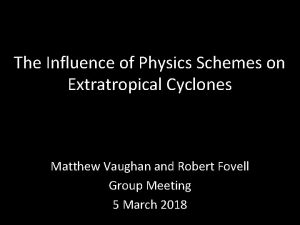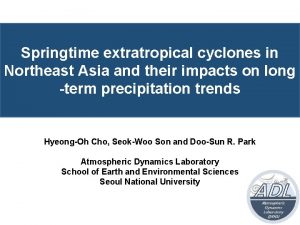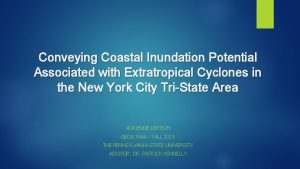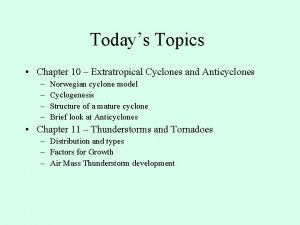SO 254 Extratropical cyclones View of an extratropical












- Slides: 12

SO 254 Extratropical cyclones View of an extratropical cyclone from above (top panel) and from the side (bottom panel). In top panel, gray lines are isobars with pressures in mb, red L indicates the center of the extratropical cyclone, colored arrows represent surface wind direction, magnitude, and temperature, blue shading indicates precipitation, and fronts are indicated by colored symbols. In the bottom panel, a vertical cross section is presented for the dashed pink line A to B in the top panel. Source: http: //courses. knox. edu/envs 150/overheads/topsidecyclone. JPG

What is an extratropical cyclone? • An extratropical cyclone (ETC) is an area of low pressure, often migratory and with frontal boundaries, typical of the middle and high latitude regions of the world • ETCs develop as part of cyclogenesis: • During cyclogenesis, vorticity (spin) of low-level air increases, updrafts increase near the center, and surface pressure decreases • The life cycle of an extratropical cyclone typically lasts 4 -8 days • Key processes that favor cyclogenesis include: divergence aloft, surface air convergence, advection of cyclonic vorticity aloft, warm- and cold-air advection near the surface • Key processes that disrupt cyclogenesis include: surface friction, convergence aloft, advection of anticyclonic vorticity aloft

Life cycle of an ETC: Step 1 • First step: • Region of upper-level divergence and/or upper-level vorticity advection moves overhead of a surface temperature gradient • Consequence of first step: • Air rises in the area beneath the divergence and/or the vorticity advection • Rising air stretches the air column, causing it to rotate Surface front (stationary), clouds (gray shaded), temperatures (dashed lines) and isobars (solid black lines, in kilo. Pascals) • This stage is called the “spin up” stage Surface convergence Upper-level jet stream (dashed arrow) and region of upper-level divergence (labeled “D”)

Life cycle of an ETC: Step 2 • (First step still remains in place) • Region of upper-level divergence and/or upper-level vorticity advection remains overhead of a surface temperature gradient • Second step: • Fronts develop. A warm front develops at the leading edge of the warm air moving north to the east of the ETC. A cold front develops at the leading edge of the cold air moving southeast to the west of the ETC. • Consequence of second step: • The wavelength of the upper-level jet trough and jet stream shortens. Divergence aloft and positive vorticity advection aloft both increase. • This stage is called the “frontal wave” stage During “frontal wave” stage: a “wave” of low pressure develops along a stationary temperature gradient, in response to forcing from aloft

Life cycle of an ETC: Step 3 • (First two steps still remain in place) • Region of upper-level divergence and/or upper-level vorticity advection remains overhead of a surface temperature gradient • Warm- and cold-air advection continue occurring in the lower atmosphere, acting to build a ridge ahead of the ETC and a trough behind it. Surface fronts are also becoming well defined • Third step: • Surface air pressures fall (sometimes quickly), at the core center of the ETC. Precipitation, sometimes heavy, develops along the frontal boundaries. Upper-level divergence and vorticity advection are maximized. • Consequence of third step: • Falling surface pressures promote intensification of surface temperature gradients, a process called frontogenesis • This stage is called the “deepening” stage During “deepening” stage: Air circulation around developing low pressure moves warm air north and cold air south, transforming stationary frontal boundary into a warm front and a cold front

Life cycle of an ETC: Step 4 • (First three steps still remain in place) • Region of upper-level divergence and/or upper-level vorticity advection remains overhead of a surface temperature gradient • Warm- and cold-air advection continue occurring in the lower atmosphere, acting to build a ridge ahead of the ETC and a trough behind it. Surface fronts are also becoming well defined • Surface pressures fall in the center of the low • Fourth step: • Precipitation and latent heat release promote quick deepening of surface low pressure. Cold air advances faster south and east than warm air advances north and west. Surface winds are maximized, upper-level trough is deepest, divergence aloft and vorticity advection aloft are strongest • Consequence of fourth step: • Surface pressures are lowest, precipitation rates greatest, winds strongest • This stage is called the “mature” stage During “mature” stage: Lowest central pressure of the ETC, greatest surface wind speeds, heaviest precipitation, most intense fronts (most intense temperature gradients)

Life cycle of an ETC: Step 5 • Fifth step: Cold front overtakes warm front • Consequences of fifth step: • Surface temperature gradient weakens and shifts east of the ETC • Cold-air advection located east of the ETC causes upper-level trough to move east, with axis of upper-level trough now east of surface low • Upper-level convergence and anticyclonic vorticity advection are now present overhead of the surface low • Both promote sinking air in the column over the surface low • Cyclolysis (weakening) occurs, until eventual dissipation of the ETC • This stage is called the “decay” stage During “decay” stages: Cold front overtakes warm front, shifts greatest temperature gradients east of ETC center. Cold-air advection shifts east, helping upperlevel trough to move east, and replacing upperlevel divergence/cyclonic vorticity advection with upper-level convergence and anticyclonic vorticity advection over the surface low.

Evolution of frontal boundaries during ETC life cycle • Frontal wave (a) • Stationary front still (little circulation around surface low) • Mature cyclone (b) • Strong winds around surface low • Cold front nearly overtakes warm front • Decay (c) • Cold front overtakes warm front • Surface low pressure separated from strong temperature gradients

Another view of ETC development • View from top: surface low located to the east of trough axis, ideally beneath area of greatest divergence aloft and area of maximum cyclonic vorticity advection • It’s possible, in the real atmosphere, that the area of greatest divergence aloft doesn’t align with the area of maximum cyclonic vorticity advection “Warm air conveyor belt” typically occurs between 850 mb (at the entrance region of the gray arrow) and 200 mb (the exit region of the gray arrow). It is responsible for providing latent energy for the developing ETC

Extratropical anticyclones • Just like surface extratropical cyclones develop as areas of low pressure to the east of an upper-level trough axis, surface extratropical anticyclones can develop as areas of high pressure to the east of an upper-level ridge axis

Relative importance of different processes to ETC cycle • To conclude this lesson, let’s look at the approximate relative importance of each type of process to the ETC life cycle: • Upper-level divergence and vorticity advection (blue curve) • Latent heat release from water vapor forming liquid and ice particles (brown curve) • Friction (green curve) • Net effect of all: dashed purple curve

Where are the ETCs in this analysis of the Pacific Ocean, provided by NOAA Ocean Prediction Center? What stages are they in? Finally, how do we read/interpret the surface station model?
